Urban Tree Canopy: Baltimore’s Living Umbrella
By Amy Nelson
By Erik Dihle, Charles Murphy, Desiree Shelley, and Ted Martello
City of Baltimore, TreeBaltimore
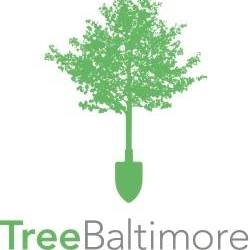 TreeBaltimore was started in 2007, as a mayoral initiative, to increase Baltimore City’s Urban Tree Canopy (UTC). The first few years were spent putting together the plan on which it would operate. In 2009, five-hundred thousand dollars were allotted to get the program operational. The initial goal was to increase tree canopy coverage to 40%, the UTC percentage required to be deemed a Healthy City by American Forests. The UTC was thought to be 20%. By 2009, cleaner data and better analysis would show that the City actually had 27.4% and was adopted into the City’s first Sustainability’s Plan. Over the past eight years, TreeBaltimore has seen its role shift and change with the landscape of funding and opportunity. Through the TreeBaltimore partnership, tens of thousands of trees have been planted throughout Baltimore.
TreeBaltimore was started in 2007, as a mayoral initiative, to increase Baltimore City’s Urban Tree Canopy (UTC). The first few years were spent putting together the plan on which it would operate. In 2009, five-hundred thousand dollars were allotted to get the program operational. The initial goal was to increase tree canopy coverage to 40%, the UTC percentage required to be deemed a Healthy City by American Forests. The UTC was thought to be 20%. By 2009, cleaner data and better analysis would show that the City actually had 27.4% and was adopted into the City’s first Sustainability’s Plan. Over the past eight years, TreeBaltimore has seen its role shift and change with the landscape of funding and opportunity. Through the TreeBaltimore partnership, tens of thousands of trees have been planted throughout Baltimore.
Operating as the umbrella organization for all tree planting in Baltimore City, the TreeBaltimore partnership includes City agencies, non-profits, private companies and individual citizens. At the beginning of operations, the TreeBaltimore initiative focused on mass tree plantings throughout the City’s vast park and school systems. Planting thousands of trees on large open-space with sparse canopy was a quick way to gain momentum. Several years of location-based plantings deemed to be extremely successful. These “low hanging fruit” locations receiving hundreds of trees were eventually all planted up. With momentum and a grassroots following, the next big hurdle became apparent: impervious surface.
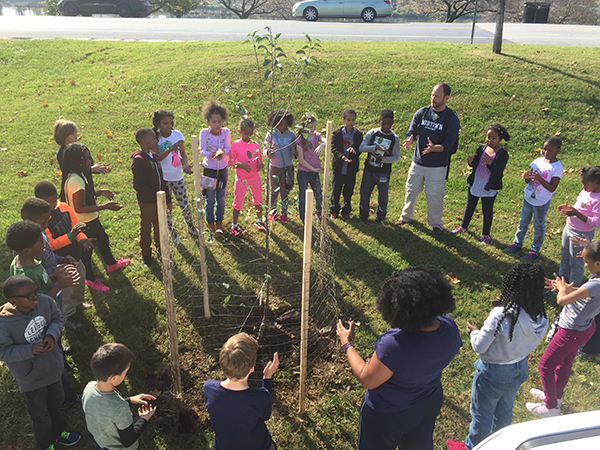
The push to go into neighborhoods started with vacant lot restoration by non-profit partners, community associations and individuals. Then through partnerships, evolving best management practices, and funding; large scale impervious removal and tree plantings started in high-priority neighborhoods. Tying into urban needs such as storm water management and heat island mitigation enabled funding opportunities for our partnership’s efforts.
The Priority Planting Map, released in 2011, is a key funding tool used by connecting multiple priorities within a specific neighborhood. The map helps identify neighborhoods that are high priority for not only the funding source but also tree planting. Today, with non-profits and city agencies prioritizing street tree plantings, much effort is directed towards the creation of sidewalk tree pits each year.
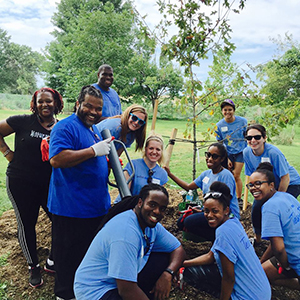
In the greening world, “grassroots” truly takes on several meanings. Partnerships are key to growing from the ground up. Whether it’s a citizen interested in a single tree, a non-profit planting thousands, or a corporation bringing funding, we are all in it together. There are no partnerships too small or too big, nor are there too few.
While a strong emphasis is placed on planting young trees, the TreeBaltimore canopy goal reflects the City’s holistic effort with its trees including: improved care for young and mature specimens, community engagement and education, as well as efforts to address forest health and invasive species. Improved care for city-owned trees also involves a comprehensive inventory.
Starting this summer and over the next few years, every street tree will be mapped in the first-ever comprehensive street tree inventory for the City of Baltimore. The inventory will include trees in developed areas of city parks, as well as, locations where new trees could be planted. New software will streamline management of the inventory with real time maintenance logging, while also, connecting with the City’s service request system. Tree species and age distribution will be readily evident and will inform infill plantings as well as tree selection in a given location.
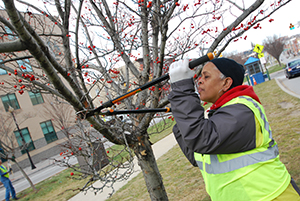
A much needed–but missing–component for continued growth of Baltimore’s tree canopy is the structural pruning of existing, mature specimens. Long neglected due to budgetary constraints, the city last year began to embrace the concept of proactive pruning for each of Baltimore’s 250-plus neighborhoods. Simply put, each street tree five inches and over in caliper is being pruned to produce a framework with strong, scaffold limbs that can withstand storm damage. Continually rotating through the neighborhoods, the City demonstrates that healthy canopy growth requires multi-pronged approach. Large tree pruning coincides with tree planting and maintenance efforts in a given neighborhood to ensure trees of all ages receive care. Volunteers pick up pruning responsibilities of smaller diameter trees.
The multi-partner program, Baltimore TreeKeepers, engages citizens through training and hands on tree stewardship projects. Young tree pruning and plantings are successful in getting volunteers the experience needed to take initiative and host similar events in their neighborhoods. Much camaraderie is present amongst the TreeKeeper membership old and new during these events. Another similarly modeled program is known as Weed Warriors.
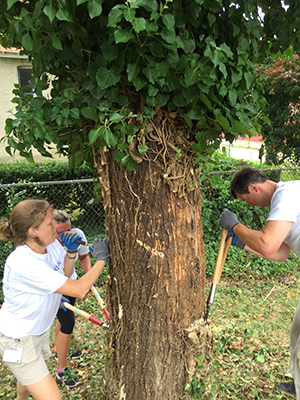
The Baltimore Weed Warriors program trains and certifies volunteers and partnership staff to become community advocates and to manage invasive vegetation in park lands. A three part class series combined with hands on invasive removal projects, participants gain an appreciation of invasive plant ecology, and management strategies. The class curriculum includes identification of each invasive species of concern, their impacts on the urban ecosystem, removal methods, removal data and observation reporting, and leadership training.
An interactive removal map on the TreeBaltimore website, displays spatial data points for all of the removal projects in parks. Each point provides information such as the level of infestation, habitat type, species removed, removal methods and quantity of biomass. This tracking tool, combined with species observation data from the Mid Atlantic Early Detection Network app, will continue to help guide the department’s invasive vegetation management decisions.
Volunteers are at the core of the greening community; top notch training and certification courses keep them engaged. While recognizing the immense accomplishments of their efforts, TreeBaltimore also acknowledges the potential of having a comprehensive plan of action for the management of the park system’s largest undeveloped woodland areas.
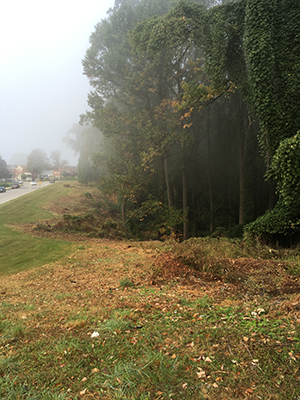
Through a professional services contract awarded last summer, Biohabitats, Inc. will soon be releasing a specific blueprint the City can adopt to improve the long term health of the forest canopy found within Gwynns Falls–Leakin Park’s 940 acres. This forest management plan is expected in May 2017, and will be the first of its kind in Baltimore City. The plan will offer an extensive set of forest data and analyses by which stand improvement recommendations and priority zones are to be identified. Budgeted recommendations for forest restoration projects will provide an actionable plan for pursuing funding. A large focus will be set on the management of invasive vegetation impacting understory regeneration and forest canopy health. Thanks to private mitigation funding available through Baltimore’s Office of Planning and Sustainability, there are plans to continue this model for our remaining parks that contain large tracts of woodlands.
 Community engagement, volunteer stewardship, and environmental education are at the heart of the TreeBaltimore partnership. Quarterly meetings and winter and summer celebrations have been valuable as a foundation for networking amongst partners. The partnership works to host engaging lectures, workshops, seminars, and field experiences which are often open to the public. Community folks continued to ask for fruit trees, so we started giving them fruit trees. Our partners with the local forestry board went out on a limb and constructed a mobile, Dr. Suess inspired, truffula-tree-themed, sculpture to compete in a local event known as the Kinetic Sculpture Race.
Community engagement, volunteer stewardship, and environmental education are at the heart of the TreeBaltimore partnership. Quarterly meetings and winter and summer celebrations have been valuable as a foundation for networking amongst partners. The partnership works to host engaging lectures, workshops, seminars, and field experiences which are often open to the public. Community folks continued to ask for fruit trees, so we started giving them fruit trees. Our partners with the local forestry board went out on a limb and constructed a mobile, Dr. Suess inspired, truffula-tree-themed, sculpture to compete in a local event known as the Kinetic Sculpture Race.
We are continually looking to bring new people into the mix. TreeBaltimore’s online notable tree map is one example of how we might get a tech savvy millennial more excited about trees. Offering notable tree bus tours might get a history enthusiast more excited about advocating for trees. New partnerships arise from our efforts to foster appreciation while gaining an understanding of the communities’ particular interests. The key message here is to diversify, you never know when the next “Lorax” will come around.
The Priority Planting Map, released in 2011, is a key funding tool used by connecting multiple priorities within a specific neighborhood. The map helps identify neighborhoods that are high priority for not only the funding source but also tree planting. Today, with non-profits and city agencies prioritizing street tree plantings, much effort is directed towards the creation of sidewalk tree pits each year.
Starting this summer and over the next few years, every street tree will be mapped in the first-ever comprehensive street tree inventory for the City of Baltimore. The inventory will include trees in developed areas of city parks, as well as, locations where new trees could be planted. New software will streamline management of the inventory with real time maintenance logging, while also, connecting with the City’s service request system. Tree species and age distribution will be readily evident and will inform infill plantings as well as tree selection in a given location.
A much needed–but missing–component for continued growth of Baltimore’s tree canopy is the structural pruning of existing, mature specimens. Long neglected due to budgetary constraints, the city last year began to embrace the concept of proactive pruning for each of Baltimore’s 250-plus neighborhoods. Simply put, each street tree five inches and over in caliper is being pruned to produce a framework with strong, scaffold limbs that can withstand storm damage. Continually rotating through the neighborhoods, the City demonstrates that healthy canopy growth requires multi-pronged approach. Large tree pruning coincides with tree planting and maintenance efforts in a given neighborhood to ensure trees of all ages receive care. Volunteers pick up pruning responsibilities of smaller diameter trees.
The Baltimore Weed Warriors program trains and certifies volunteers and partnership staff to become community advocates and to manage invasive vegetation in park lands. A three part class series combined with hands on invasive removal projects, participants gain an appreciation of invasive plant ecology, and management strategies. The class curriculum includes identification of each invasive species of concern, their impacts on the urban ecosystem, removal methods, removal data and observation reporting, and leadership training.
We are continually looking to bring new people into the mix. TreeBaltimore’s online notable tree map is one example of how we might get a tech savvy millennial more excited about trees. Offering notable tree bus tours might get a history enthusiast more excited about advocating for trees. New partnerships arise from our efforts to foster appreciation while gaining an understanding of the communities’ particular interests. The key message here is to diversify, you never know when the next “Lorax” will come around.
